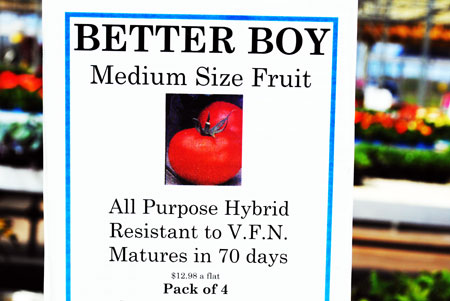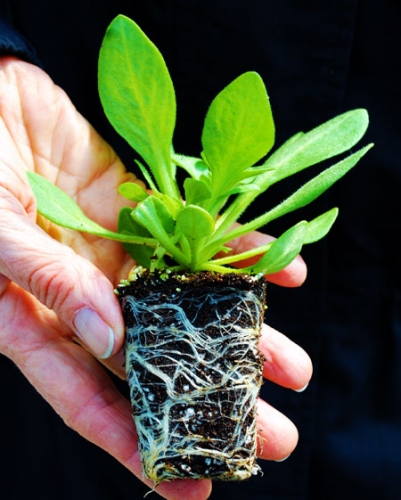Grow like a pro: Shop smart and pick the best plants
Select healthy transplants to ensure a great start to a productive garden this season.

If you’re like me, you’re starting to plan out the varieties of vegetables, flowers, perennials, trees and shrubs that you’ll be adding to your garden this season. For as long as you might spend mulling over seed catalogs and plant selection guides, remembering to spend some time inspecting the plant material you’re putting into your garden matters too. Choosing vigorous, pest-free plants sets the stage for a productive and attractive garden. Healthy transplants are more likely to establish quickly, resist pests and diseases, and reward you with earlier and more abundant harvests.
Here are a few shopping tips from Michigan State University Extension.
Purchase plants from a reputable source. Buy your plants from an established greenhouse grower or garden center. It’s generally a safe bet that a company that has been doing business for many years has managed to stay in business so long by providing a quality product. Don’t know of any greenhouses or garden centers in your area? Be bold, talk to a neighbor, friend or family member you trust. You could also search online to find options for where to shop near you. Be sure that if you find plants to purchase online, you know the supplier well and that they are a reputable greenhouse or nursery retailer.
Also, keep in mind that Michigan State University (MSU) Extension does not recommend or endorse any particular businesses, but we can provide a list of options in your area and provide helpful resources for your search. For instance, looking for reputable tree care? Check out treesaregood.org for a list of International Society of Arboriculture certified arborists in your area. Maybe you’re looking for pollinator-friendly native plants? Then head to the Northern Bee Network’s Find a Producer page for lists of native plant producers in Michigan.
The best way to discover your favorite local garden center is to get out there and explore. Take note of which places are convenient, have helpful resources and staff, and carry what you’re looking for.
Select disease resistant plants. Resistant or tolerant varieties are generally noted by a letter (or series of letters) code on the plant tag in the pot or cell pack. For example, “VF” means the variety is resistant to Verticillium and Fusarium wilts. However, this does not mean the variety is resistant to all diseases. When selecting for disease resistance, think back on problems that have been common to your garden in the past. Maybe your peonies struggle with powdery mildew every year or perhaps you have an apple that suffers from cedar-apple rust regularly.
Here’s a table of some of the most common garden disease issues that may be encountered in Michigan.
|
Plant |
Disease |
|---|---|
|
monarda |
powdery mildew |
|
phlox |
powdery mildew |
|
rose |
black spot, powdery mildew |
|
zinnia |
powdery mildew |
|
apple |
scab, cedar-apple rust, fire blight, powdery mildew |
|
asparagus |
rust |
|
beans |
powdery mildew, downy mildew, rust, various viruses |
|
broccoli |
black rot, downy mildew |
|
cucumber |
bacterial wilt, powdery mildew, downy mildew, various viruses |
|
pea |
Fusarium wilt, powdery mildew, downy mildew, various viruses |
|
pepper |
Verticillium wilt, various viruses |
|
sweet corn |
rust, smut, Stewart's wilt, anthracnose, other foliar diseases |
|
tomato |
Fusarium wilt, Verticillium wilt, Tobacco Mosaic virus, early blight |
Chart adapted from Iowa State University Extension and Outreach, Selecting Disease Resistant Plants.

Think about key features. Select the right plant for the right place, keeping in mind any constraints your garden might have. Growing in a container? Look for “Patio” or “Bush” type transplants denoting that they’ll perform well in containers. For fruiting crops like melons, shorter maturity dates will be important when planting in northern climates to ensure you have time to harvest your crop before fall freezes start.
Short on space? Look for trees and shrubs that are “Skinny”, “Compact” or “Columnar” to ensure you’ll be able to squeeze them in to your valuable garden real estate. It’s also especially important to consider deer resistance if you’ve had problems with deer browsing in the past.

Closely inspect plants for signs of insects, diseases or poor care. Select sturdy, stout plants with deep green or appropriately colored leaves. Avoid plants with leaves that are dropping, wilted, curled, spotted or have holes or brown leaf edges. Lightly brush over the plants with your hands. If a cloud of white, fly-like insects appears, do not purchase those plants. Closely inspect plants looking under leaves and at stems within the canopy for common pests like whiteflies, aphids or mealybugs.
Plants should be short and stocky rather than tall and leggy, indicating they didn’t receive enough light due to poor spacing. Check the stems for lesions or discoloration, which indicates the presence of a disease. Pull a few transplants from their containers and inspect the root system. Avoid those that have a tangle of roots encircling the root ball. Also, make sure the roots are white and fibrous. Avoid plants with brown or black roots, but due note that some perennials, trees and shrubs naturally have darker colored roots. Even if a perennial, tree or shrub has tan to brown roots, they should never be mushy or have a putrid smell.

Remove flowers. While this may be a shock to you, your new transplants will benefit from this act. Especially when it comes to annual vegetables and flowers, young transplants without flowers will adjust to their move from the pot to the garden more readily than those in full bloom. Flowering transplants expend their energy on flowering and forming seeds instead of developing roots. You can help flowering plants adjust to garden growing conditions by simply removing the flowers when you plant them into the garden. It may be difficult to remove the beautiful flowers you’ve waited all winter for, but a little sacrifice now will increase flowering (and fruiting) throughout the season.
Resist the urge to plant too early. Keep in mind that the right planting time varies by region and crop, so even if the weather feels inviting, it might not be time to plant just yet. Generally, in Michigan, it’s time to plant most summer vegetable and flower transplants between May 15 and June 1, but be sure to know your area’s frost-free date. Use this frost-free chart to check local guidelines for Michigan, or check soil temperature data which you can find at MSU Enviroweather to ensure you're planting at the optimal time for success.
For additional gardening information, contact the MSU Extension lawn and garden toll-free hotline at 1-888-678-3464 or visit the Gardening in Michigan website.



 Print
Print Email
Email



